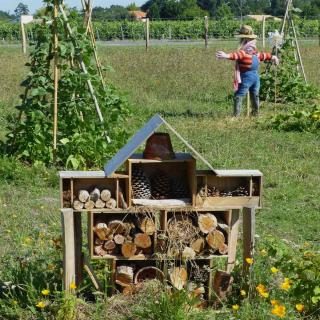

Rooted in both ancestral knowledge and innovation, the answer to the question “What is permaculture?” is straightforward. It is the practice of observing nature to learn from what it can teach us, aiming for food self-reliance and abundance.
Australian biologist Bill Mollison conceptualized the notion of “permanent agriculture” in the ‘70s, and, these days, it is being acclaimed all over the world. Permaculture is highly relevant on urban farms as they multiply in the wake of the Incredible Edibles movement. The ultimate goal of permaculture ?
To feed the planet – in a sustainable manner.
What a challenge!
“The Permaculture movement has gained momentum in the past few years, shares Carine Mayo, who wrote the book Le Guide de la Permaculture au jardin [A guide to permaculture in the garden]. It gives answers to those who dream of an oil-free society, or who simply want to connect to nature within their own garden.”
“Monocropping and chemical fertilizers render more and more agricultural land unusable”, writes Le Bio Grow Book author Karel Schelfhout. “Since it relies on setting up ecosystems, permaculture lets the earth breath anew, gives the gardener new responsibilities, and represents a new hope for health and for the consumption of plants”.
Bill Mollison presents his target in his book, Permaculture: A Designers’ Manual:
“It should be possible to harvest without sowing every year, to protect the soil with a permanent cover, to combine agriculture with forestry…
This actually matches many practices observed in our countries and in the world. Many ingenious farmers already unwittingly follow permaculture guidelines! Bill Mollison shows that this concept encompasses much more than just agriculture: it’s a new way to envision humanity as a part of our local environment. This can inspire us to rely on permaculture as we enhance our gardens, for every little step counts.

In our gardens, the trick is to adapt these principles to individual small-scale plots:
“This agriculture relies on photosynthesis, adds Bill Mollison. The first thing to do is to maximize the free energy the Sun gives us; this means we must add as many layers as is possible.”
As years go by, plants propagate naturally, watering is reduced, and the gardener’s work evolves to merely observing events, carefully adjusting details, and harvesting only what is needed.
“When implemented in people’s gardens, permaculture produces amazing results, emphasizes Carine Mayo. Perfect for those who want to produce their own food, permaculture is also more than just aiming to harvest. It’s a philosophy, a global approach that arises from an ethical mindset with three basic principles: caring for the Earth, caring for human beings, and sharing resources and harvests fairly”.
Sepp & Margit Brunner, who wrote the book Permaculture for all, even hint that this is the dawn of “a new understanding of the world”.
To learn more, read some of the following excellent books (some are only available in French):
Read also:
Claire Lelong-Lehoang